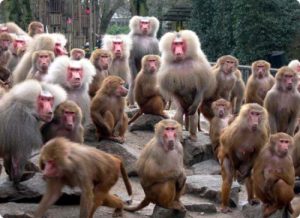How big is your Monkeysphere?
How are you with remembering names and faces?
People work hard at improving this crucial skill. A quick Google search can reveal various techniques.
Understanding our limits in this area is the first step toward improving. As it turns out, science has actually quantified how many people we can realistically expect to be able to remember; there’s even a term for it: Monkeysphere.
Wikipedia defines the Monkeysphere (aka Dunbar’s Number) as:
a suggested cognitive limit to the number of people with whom one can maintain stable social relationships. These are relationships in which an individual knows who each person is and how each person relates to every other person.
Cracked.com provides this helpful example:
First, picture a monkey. A monkey dressed like a little pirate, if that helps you. We’ll call him Slappy.
Imagine you have Slappy as a pet. Imagine a personality for him. Maybe you and he have little pirate monkey adventures and maybe even join up to fight crime. Think how sad you’d be if Slappy died.
Now, imagine you get four more monkeys. We’ll call them Tito, Bubbles, Marcel and ShitTosser. Imagine personalities for each of them now. Maybe one is aggressive, one is affectionate, one is quiet, the other just throws shit all the time. But they’re all your personal monkey friends.
Now imagine a hundred monkeys.
Not so easy now, is it? So how many monkeys would you have to own before you couldn’t remember their names? At what point, in your mind, do your beloved pets become just a faceless sea of monkey? Even though each one is every bit the monkey Slappy was, there’s a certain point where you will no longer really care if one of them dies.
The science behind this tells us that a part of our brain called the neocortex is what governs how big our monkeysphere can be. For a chimp, this is about 60. For a human, studies show that the number seems to be between 150 and 350.
From Urban Dictionary:
The idea that people you know well (those in your “monkeysphere”) are more important to you than others (those outside your “monkeysphere”)
That’s why they don’t mind stealing your stereo or vandalizing your house or cutting your wages or raising your taxes or bombing your office building or choking your computer with spam advertising diet and penis drugs they know don’t work. You’re outside their Monkeysphere. In their mind, you’re just a vague shape with a pocket full of money for the taking.
Do you want your customers to think you feel this way about them? Do you actually want to feel this way about them? Hopefully the answer to both questions is “No.”
But, the reality is that you probably already have a big troupe of people crowding your monkeysphere: friends, relatives, neighbors, co-workers, that one barrista…
CRM to the rescue!
The Monkeysphere is kind of the whole reason CRM exists. If you imagine your CRM database as an extension of your neocortex, you’ll begin to see the value.
Put information about your customers into your CRM system — who are they? what are their interests? did they share something about their kids? It’s all relationship-building information that can keep them in your monkeysphere — and you in theirs!
When you and your business contacts are in one another’s monkeysphere, you can genuinely care about one another’s success and can better work together to achieve your mutual goals. When you’re not, it can be a lot more difficult.
So, go ahead, create a new contact record and expand your neocortex.







